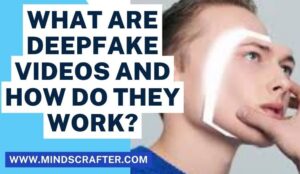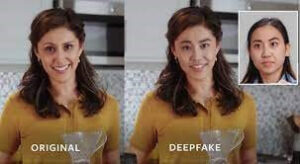
deep-fake-videos
Deepfake videos are a new type of manipulated media that use artificial intelligence to create realistic but fake videos. These videos can be used to spread misinformation, create fake news, or even impersonate someone else. This short article explains what deepfake videos are, how they work, and why they’re becoming increasingly popular.
What are deepfake videos?
Deepfake videos are a type of manipulated media that use artificial intelligence to create realistic but fake videos. They involve taking existing footage of a person and using machine learning algorithms to manipulate their facial expressions and movements, making it appear as though they are saying or doing something they never actually did. These videos can be used to spread misinformation, create fake news, or even impersonate someone else.

Deepfake videos have become increasingly sophisticated in recent years, with some being almost indistinguishable from real footage.Deepfakes have found application in diverse realms, ranging from the creation of fabricated explicit videos involving celebrities to the dissemination of political propaganda. The underlying technology powering deepfakes continues to advance, presenting a challenge in effectively identifying and mitigating their proliferation. Consequently, increasing apprehension surrounds the potential societal repercussions of deepfake videos, prompting endeavors to devise tools and tactics to counter their misuse.
How do deepfake videos work?
Deepfake videos use machine learning algorithms to analyze and manipulate existing footage of a person’s face and body movements. The algorithms then create a new video that appears to be the person saying or doing something they never actually did. The process involves training the algorithm on a large dataset of images and videos of the person, allowing it to learn their facial expressions and movements. The more data the algorithm has, the more realistic the deepfake video will appear. As technology continues to advance, deepfake videos are becoming increasingly difficult to detect, making it important to be cautious when consuming media online.
The technology behind deepfakes is constantly evolving, as developers continually create new algorithms and techniques to produce increasingly realistic videos. According to some experts, there is a prediction that deepfakes may eventually enable the creation of entirely fabricated personas, further blurring the line between reality and fiction. As the threat of deepfakes continues to grow, it is important for individuals and organizations to stay informed and take steps to protect themselves from this emerging technology. Some important tools for creating deepfake videos.
- DeepFaceLab
- Faceswap
- FakeApp
- Deep Art Effects
- Zao
- Avatarify
The potential dangers of deepfake videos:
While deepfake videos can be entertaining and even humorous, they also pose potential dangers. For example, individuals could use deepfake videos to spread false information or propaganda, manipulate public opinion, or even blackmail others. Additionally, deepfake videos could be employed to fabricate evidence in legal cases, resulting in wrongful convictions or acquittals. As technology continues to advance, it’s important to be aware of the potential dangers of deepfake videos and to approach all media consumption with a critical eye.
Deepfake videos are fake videos made by using computers and special software. Some deepfakes are just for fun, but others can be dangerous. For example, a deepfake video could make people think a politician said something bad, which could change people’s minds about them. Deepfakes could also be used to hurt someone by making it look like they did something wrong.
How to spot a deepfake video:
Deepfake videos are becoming increasingly difficult to detect as the technology used to create them becomes more sophisticated. However, there are some signs that you can look for to help identify a deepfake video:
-
Facial inconsistencies: Deepfake videos often have inconsistencies in the facial features of the subject. For example, unnatural blinking of the eyes or mismatched mouth movements with spoken words may occur.
-
Lighting and shadows: Pay attention to the lighting and shadows in the video. Deepfake videos may have lighting or shadows that are inconsistent with the environment or the source footage.
-
Unnatural movements: Deepfake videos may have unnatural movements, such as jerky or stuttering movements, due to the limitations of the AI algorithm used to create them.
-
Audio mismatches: Deepfake videos may have audio that doesn’t match the movements of the mouth or the tone of the voice.
-
Unusual backgrounds: Deepfake videos may have unusual or inconsistent backgrounds that don’t match the source footage or the environment.
Are there any software to detect the deepfake video?
So good news is yes, there are some software tools and technologies available for detecting deepfake videos. However, it’s important to note that these tools are not foolproof, and deepfake detection is still an active area of research and development. Some of the deepfake detection software and technologies currently available include:
- Sensity AI: Sensity AI is a deepfake detection company that provides software tools for detecting deepfake videos, images, and audio.
- Amber Authenticate: Amber Authenticate is a software tool that uses blockchain technology to verify the authenticity of videos and images, making it harder for deepfakes to go undetected.
- Deepware Detection: Deepware Detection is a deep learning-based technology that can detect deepfakes by analyzing facial movements and comparing them to the source footage.
- Truepic: Truepic is a platform that uses cryptography and blockchain technology to verify the authenticity of images and videos, making it harder for deepfakes to go undetected.
- Microsoft Video Authenticator: Microsoft’s Video Authenticator is a tool that analyzes videos and assigns a confidence score to indicate the likelihood of the video being a deepfake.
While these tools can help detect deepfake videos, they are not foolproof and may not detect all deepfakes. It’s still important to be cautious and verify the source and authenticity of any video or information before accepting it as true.

Shabbir Ahmed khan